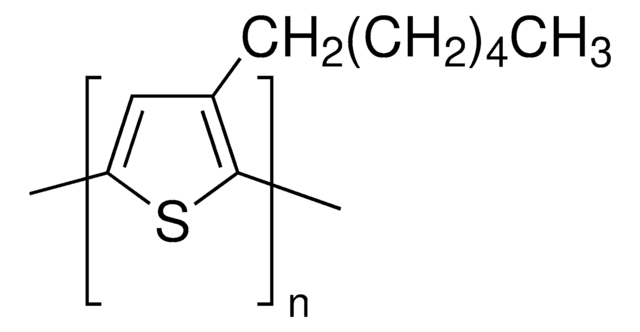739278
6,13-Bis((triethylsilyl)ethynyl)pentacene
≥99% (HPLC)
Synonym(s):
TES pentacene
About This Item
Recommended Products
Assay
≥99% (HPLC)
form
crystals
mp
261-266 °C
semiconductor properties
P-type (mobility=10−5 cm2/V·s)
SMILES string
CC[Si](CC)(CC)C#Cc1c2cc3ccccc3cc2c(C#C[Si](CC)(CC)CC)c4cc5ccccc5cc14
InChI
1S/C38H42Si2/c1-7-39(8-2,9-3)23-21-33-35-25-29-17-13-15-19-31(29)27-37(35)34(22-24-40(10-4,11-5)12-6)38-28-32-20-16-14-18-30(32)26-36(33)38/h13-20,25-28H,7-12H2,1-6H3
InChI key
WSBQAUOFFOKRMX-UHFFFAOYSA-N
Application
Signal Word
Warning
Hazard Statements
Precautionary Statements
Hazard Classifications
Eye Irrit. 2 - Skin Irrit. 2 - STOT SE 3
Target Organs
Respiratory system
Storage Class Code
11 - Combustible Solids
WGK
WGK 3
Flash Point(F)
Not applicable
Flash Point(C)
Not applicable
Choose from one of the most recent versions:
Certificates of Analysis (COA)
Don't see the Right Version?
If you require a particular version, you can look up a specific certificate by the Lot or Batch number.
Already Own This Product?
Find documentation for the products that you have recently purchased in the Document Library.
Articles
Small molecular weight organic semiconductors are promising for flexible transistor applications in next-gen soft electronics.
Organic materials in optoelectronic devices like LEDs and solar cells are of significant academic and commercial interest.
Intrinsically stretchable active layers for organic field-effect transistors (OFET) are discussed. Polymer structural modification & post-polymerization modifications are 2 methods to achieve this.
Solution-processed organic photovoltaic devices (OPVs) have emerged as a promising clean energy generating technology due to their ease of fabrication, potential to enable low-cost manufacturing via printing or coating techniques, and ability to be incorporated onto light weight, flexible substrates.
Related Content
Organic electronics utilizes organic conductors and semiconductors for applications in organic photovoltaics, organic light-emitting diodes, and organic field-effect transistors.
Our team of scientists has experience in all areas of research including Life Science, Material Science, Chemical Synthesis, Chromatography, Analytical and many others.
Contact Technical Service



